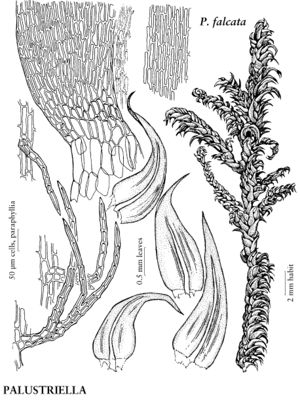Palustriella
J. Hattori Bot. Lab. 67: 223, figs. 5, 6. 1989.
| Taxon | Illustrator ⠉ | |
|---|---|---|
 | Palustriella falcata | Patricia M. Eckel |
Plants medium-sized to large, green, yellow-green, or brownish yellow. Stems sparsely pinnate or irregularly branched; hyalodermis absent, central strand weak or absent; paraphyllia present, linear to lanceolate-linear; rhizoids or rhizoid initials on stem or abaxial costa insertion, often forming tomentum, strongly branched, at least partly warty-papillose; axillary hair distal cells 2–6, hyaline. Stem-leaves not recurved or squarrose, strongly falcate to ± straight, ovate or triangular-ovate, plicate or strongly so, longer than 1 mm; base ± decurrent; margins plane or sometimes reflexed basally, distinctly denticulate usually only proximally, limbidia absent; apex long or more rarely short, acumen plane or furrowed; costa strong, single, ending in apex, sometimes weaker and shorter; alar cells differentiated, short to long-rectangular, inflated, hyaline or yellow when young, region usually well differentiated, transversely triangular or narrowly so; medial laminal cells linear, at least some usually prorate or rarely papillose abaxially; marginal cells 1-stratose. Sexual condition dioicous. Capsule horizontal, cylindric, curved; peristome perfect; exostome margins dentate distally; endostome cilia 2–3 (–4), well developed, nodose. Spores 10–23 µm.
Distribution
North America, Eurasia, n Africa, Atlantic Islands
Discussion
Species 3 (1 in the flora).
Palustriella occurs in more or less strongly calcareous wetland habitats that are at least periodically influenced by springs or otherwise moving water. Palustriella species are easily recognized by their usually strongly plicate leaves and the presence of linear to lanceolate-linear paraphyllia. They differ additionally from Cratoneuron filicinum in having a much weaker (sometimes absent) central strand, prorate or papillose instead of smooth basal laminal cells, warty-papillose instead of smooth rhizoids, well-developed axillary hairs, and exostome border much less widened at the transition zone.
Selected References
None.
Lower Taxa
"narrower" is not a number.